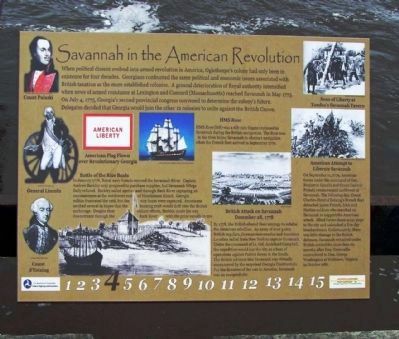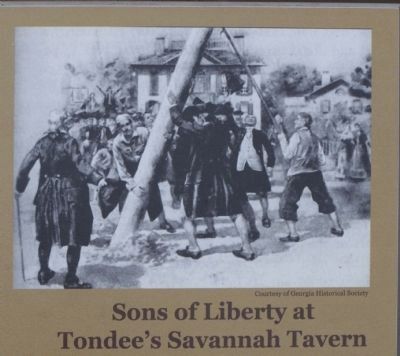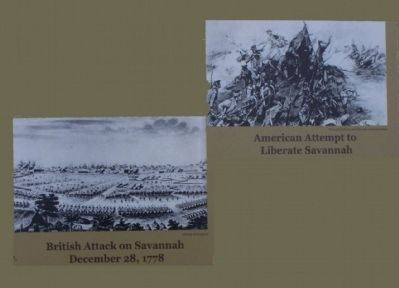Historic District - North in Savannah in Chatham County, Georgia — The American South (South Atlantic)
Savannah in the American Revolution
HMS Rose was a 6th rate frigate stationed in Savannah during the British Occupation. The Rose was in the river below Savannah to obstruct navigation when the French fleet arrived in September 1779.
Battle of the Rice Boats
In January 1776, Royal navy vessels entered the Savannah River. Captain Andrew Barkley only proposed to purchase supplies, but Savannah Whigs flatly refused. Barkley sailed upriver and through Back River capturing 26 merchantmen at the northwest end of Hutchinson Island. Georgia militia frustrated the raid, but the rice boats were captured. Americans torched several in hopes that the burning craft would drift into the British anchorage. Despite their valiant efforts, Barkley made his way downstream through the Back River with the prize vessels in tow.
British Attack on Savannah December 28, 1778
By 1778, the British altered their strategy to subdue the American rebellion. An army of over 3,000 British regulars, German mercenaries and American Loyalists sailed from New York to capture Savannah. Under the command of Lt. Col. Archibald Campbell, the expedition would use the city as a base of operations against Patriot forces in the South. The British advance into Savannah was virtually uncontested by the surprised Georgia Continentals. For the duration of the war in America, Savannah was an occupied city.
American Attempt to Liberate Savannah
On September 11, 1779, American forces under command of Gen. Benjamin Lincoln and Count Casimir Pulaski rendezvoused northwest of Savannah. The following day, Count Charles-Henri d' Estaing's French fleet debarked 3,200 French, Irish and Haitian soldiers who marched on Savannah to support the American attack. Allied forces chose to lay siege to the city and and unleashed a five- day bombardment. Unfortunately, there was little damage to the British defenses. Savannah remained under British control for more than six months after Gen. Cornwallis surrendered to Gen. George Washington at Yorktown, Virginia in October 1781.
Erected
2009 by U.S. Dept. of Transportation Federal Highway Administration, Georgia Dept. of Transportation. (Marker Number 4.)
Topics. This historical marker is listed in this topic list: War, US Revolutionary. A significant historical month for this entry is January 1776.
Location. 32° 4.904′ N, 81° 5.432′ W. Marker is in Savannah, Georgia, in Chatham County. It is in the Historic District - North. Marker is on East River Street, on the right when traveling west. Located between Drayton St. Ramp & Abercorn Ramp, at the River's edge. Touch for map. Marker is in this post office area: Savannah GA 31401, United States of America. Touch for directions.
Other nearby markers. At least 8 other markers are within walking distance of this marker. Jewish Colonists (a few steps from this marker); Savannah and the Slave Trade (within shouting distance of this marker); Savannah Waterfront (within shouting distance of this marker); African American Monument (within shouting distance of this marker); Arts & Crafts Emporium (within shouting distance of this marker); A Storeroom By Any Other Name (within shouting distance of this marker); One Building - Many Stories (within shouting distance of this marker); Vaulting Through Time (about 300 feet away, measured in a direct line). Touch for a list and map of all markers in Savannah.
Credits. This page was last revised on February 8, 2023. It was originally submitted on May 24, 2009, by Mike Stroud of Bluffton, South Carolina. This page has been viewed 2,189 times since then and 55 times this year. Photos: 1, 2, 3. submitted on May 24, 2009, by Mike Stroud of Bluffton, South Carolina. 4. submitted on May 25, 2009, by Mike Stroud of Bluffton, South Carolina. • Craig Swain was the editor who published this page.



